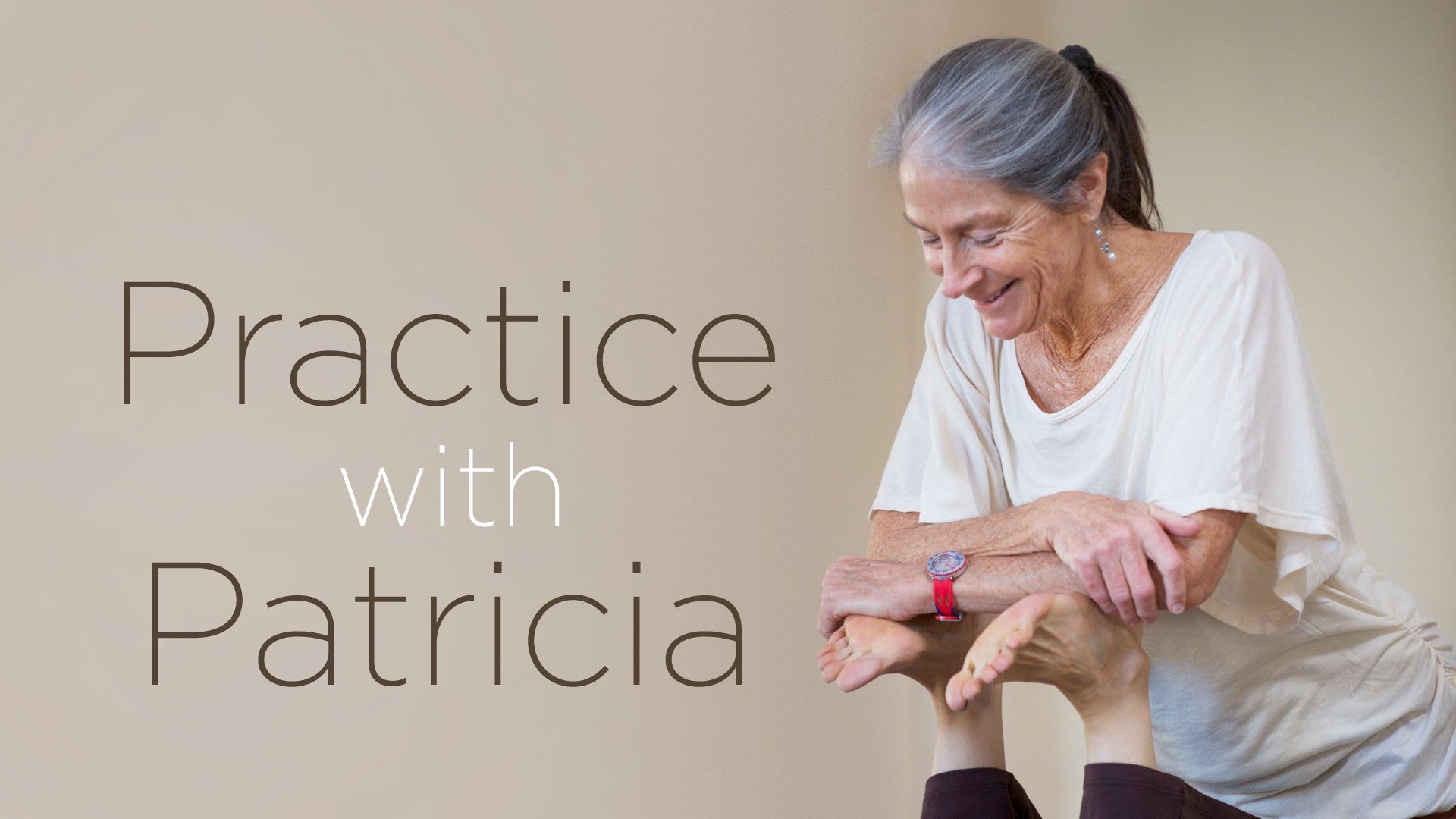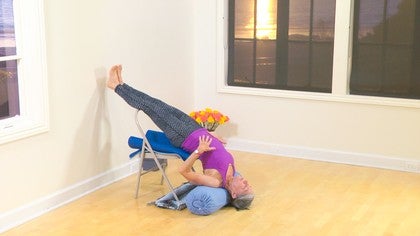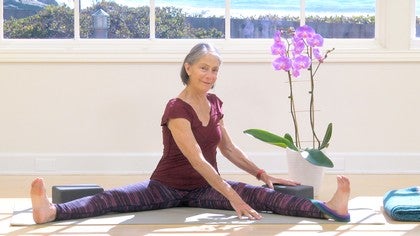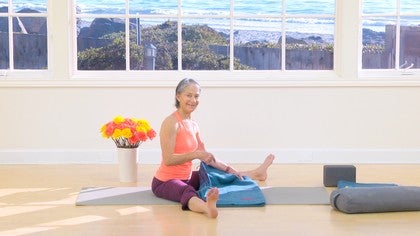Description
About This Video
Transcript
Read Full Transcript
So Shiba and Shakti have had a love affair since before time began. So I think of this work as love and longing. If we're satisfied with our earthly life, we don't see any reason to change. But if we have some sense of the immensity, the vastness, whatever, some longing may start to arise in the heart. And it's kind of painful, this longing.
But it's also sweet because it evokes the possibility for something to come into us. So Shiba is the metaphor for the expression of the unmanifest, the vast, immeasurable, incomprehensible, potentially anything can happen kind of energy. But it's unmanifest. And therefore Shiba has this longing for Shakti. Shakti is the female and she has, her power is the power of manifestation.
So Shiba, as far as evolution goes in the mind and body with Shiba and Shakti, Shiba is kind of like a devolution, comes down, sort of figures out how to pour himself down through this funnel of human. This is all legend. Down, down, down. Shakti's in there I know because this is matter and material and Shakti helps to create that. And he comes down and she's down there at the root of our spine and she's longing to come up and meet him.
And so there's this constant up and down energy in the body that can be tapped into. And one can think of inhalation as coming up the front, the front spine or the front body, exhalation pouring over the shoulders and down the back. So it could be outer body, up and down, it could be just right along the spine deep inside the core of the body and down the back. And actually when we breathe in, if we're empty, there will be space in the belly. As we empty, our diaphragm goes upward and the internal organs go back a little bit towards the spine.
And as we, that's breathing out and as we breathe in, the diaphragm goes down, pushes the organs down and we feel a sense of the breath coming to the bottom. So the energy of the breath is coming down. And then we start to feel the energy of the breath coming up. So it comes in and down in order to fill up. And they're both happening at the same time.
So in a sense Shiva and Shakti are involved in this dance of coming up and down. The energy of receiving comes in and down and the energy of letting go has to come up and out. Okay, so this can be explored quite nicely through breath and through just certain simple postures. The first posture that I'd like to work with is really just a bringing of the hands up to the back of the skull and feeling with your eight fingers the center line of the back of the skull. And then you just kind of pull on the skin of the scalp.
My eyes are going to want to close when I do this because it tends to take me inside. You pull on the skin of the scalp away from the center line broadening the back of the skull and you come around and you let the heels of your hands and the palms of your hands come around to right around the temples are. Temples are just on the out, just behind the eyes in this soft area on the skull. And as you're pulling that energy gently around the pulling the skin and allowing the flow of your awareness to come around then you imagine it coming right to the center of the forehead between the eyes and then what happens? So it's this continuum of awareness coming around from the back of the skull.
Imagine that it then enters through your eyes through the center of your skull and goes back towards the back of the skull. It comes around and it goes back and that's when your eyes start to close. It comes around and it goes back. Once you felt that with your hands you can just imagine it. And awareness is not imagination, awareness is real.
It's like love is real. Awareness, if I'm aware of my right elbow now and I really concentrate on my right elbow, I don't feel much else. And then I switch my awareness over to the left elbow or the left hand and if I keep concentrating my awareness on the left hand, pretty soon I've forgotten all about my right elbow. So awareness, letting the awareness have this dynamic movement around and imagining going back through and around again tends to be a flow, just like the imaginary flow up and down, which draws the awareness in calming, quieting, settling. Perfect kind of activity to do with yoga style breathing, pranayama.
So we're going to be breathing that love and longing. And there's another head circuit that you can imagine up the back of the skull, especially sometimes you're kind of just hanging out and the chin kind of comes up and the back of the skull goes down and there's this little bit of a fold right here. Well, when we can reach up from the base of the skull and let that reaching up come around to the crown and down over the face, just flowing down over the face and then going back right underneath the chin all the way back and through the neck and back to the base of the skull again. So you have two options here with the head. You can have this, like if you're feeling kind of slumpy or you're noticing that the back of your neck is a little bit tight, then if you just lift the base of the skull up and imagine that awareness flow coming up and across and you'll see that as I lift the base of my skull up it's almost like I'm going to pop it on a string. My whole body comes upright. It's quite wonderful. So we'll bring these back into play a little bit as we're doing some of the poses we do leading up to a bit of sitting meditation, sitting breathing and then a short meditation. And in order to prepare the body for sitting I think what we'll do is just a couple of movements that, we'll need that in a moment, that just help to wake up the, open up the rib cage and wake up the breathing mechanism and so you can come into a half dog-like position. Half dog I describe as hips behind the knees but not all the way back onto the feet and chest lower than the hips, head down on the floor if possible.
If not, use your block. So sometimes a thin block is nice for here or just a blanket edge. That holds me up too high but for some people that's just sweet. Then you're going to come up and walk around to the side. And sometimes I like to turn the palm up on the arms, one arm or the other and breathing into the side of the body where you feel the stretch. So I'm curled over to the left. That means I'm going to be feeling the stretch on the right.
Tailbone and pelvis just countering by a little bit of anchoring, pulling backward. Base of the skull open. Actually having that block there for me because I can drop down tends to close this space right here where the skull joins the neck, the back of the neck. Several breaths there and then come on up, walk over to the other side, stretch your arms out. Now you can perhaps see the side bend in my body more clearly. You're breathing into this side of the rib cage where you feel that stretch perhaps turning the thumbs up towards the ceiling, just whatever helps you to release in this pose.
Not only am I reaching back through my tail, I'm kind of curving and anchoring the hip away from my arm. Shoulder blades down the back. Now, inhaling coming back up. And then this could be just a straight half dog or it could be a half dog with a block. So I'll put the block out here in case we decide to use that. Half dog can be done with elbows up, active arms, arms reaching, especially from the outside, shoulder blades tugging away from the arm.
So we get a little extra space right across the armpit. And if you've watched this scapular tutorial, you might recognize this as my shoulder blade. If you're just looking at the skin, it's like, oh yeah, that's part of the arm or the armpit or something, but that's bone under there. That's my shoulder blade. Breathing down into the belly. As you exhale, feel the breath come up and out through the nose.
Belly hollowing back towards the pelvis and the low back. So if you can't get your head down, put a block under your head. This is another nice stretch. You can turn the thumbs out, pretend that you're hitchhiking. And that adds another dimension to the shoulder stretch.
Smoothing, attending to the breath, getting more interested in the breath than the work of the pose, just feeling the pose, but not too ambitious. Kindness rather than ambition here. Okay, now we are about to approach the infinite once again. Ananta, or Ananta, Ananta, I wish Anuradha were here, she could tell me, is the cosmic serpent. And Ananta also means the infinite in Sanskrit.
So this pose is named after the cosmic serpent who resides in all his infinite glory, somewhere out there in space where Vishnu can come around and rest on him in between taking care of the world. So Vishnu is the caretaker of the world, tries to keep things enduring and lasting. We could use a little bit of Vishnu's help on this planet right now, I think. Okay, why have I put this under here? Well, I'm going to do it without that for a moment, and you'll see that my ribcage has to really drop down.
And this feels pretty comfortable today to me. But sometimes people have told me that, oh, that's painful, or they're kind of stuck up like this. And it's sometimes not all that comfortable on the neck. So there's two things that you can do. One is to place that blanket under the ribcage.
And two is to take your trusty little block. I'm starting with this low button. Here's the bottom of my sternum. Let's support the head. So if the height here is too much stretch on the neck, you can place the block right behind your arm.
And just let your arm rest on the floor on a convenient prop right there. And you're still getting some rib stretch. So this side of the ribcage is shorter and more compressed. And this side is being stretched. And with the blanket there, I'm just rolling forward and back, and it's massaging the tissues surrounding the entirety of the ribcage.
And it helps the spaces between the ribs to relax. So there's very small muscles holding everything together there between the ribs. And this helps them to release. You can move the blanket up just a little bit and roll back and roll forward a little bit. And it's quite nice.
Just a little massage there. And then one more, maybe right up around the area. Not too high, but right up around the armpit. I sort of like to do this this way. Oh yeah, and you might just find there's a spot.
Ah, that little spot. And just about three rolls per place. You can overdo it when you're... This is almost like deep tissue massage on the side of the ribcage. You don't want to do it too long.
And then you're going to remove it and test. Do I still need the block? And how's my ribcage now as I take the form of ananta? For me right now, this is fine. And if your knees are bent, you have less stretch in the ribcage and the armpit area.
And if you straighten the legs and flex the feet, then you just get all that pull from there. It helps to bring it up into the ribcage more. So maybe you do that, maybe you don't because you don't want too much. Nice. So I'm going to come up now and the way I do that is I just roll over onto my forearms.
Lift my hips, walk my knees forward, spin around like a dog chasing its tail. Couldn't resist. So coming over here to ananta on the second side, on the side of the hip. By the way, this mat has just enough cush that it doesn't hurt my greater trochanter here, which is the bony part of the outside of the top of your leg. It's not actually the hip joint, but it's the thigh bone.
And if that is being compressed on your body, please get a blanket out and lay it out on the mat and you'll be much happier yogi or yogini. Okay, so I can feel this side of my ribcage is a little tighter than the other side. But I don't think I need the blanket. If you need the blanket, you get it out and put it under there. I can tell that if I just roll a little bit here, it's going to soften up.
Now I had quite a little lung thing going on in January and it was pretty much healed. It was a real deep cough. It was pretty much healed. And then one day I got on the floor to do this and suddenly I was coughing and releasing lots of good stuff, lots of bad stuff really. And I realized, oh, this stuff is sticking to the sides of my lungs.
And as I came into this pose and started rocking back and forth, it came out. So this must be good for the lungs. Okay, so remember you're using this block for your head if you need to or if you're just tired. And then stretching out the legs, this is very yummy. Interestingly enough, this is the posture, I think the arm would be up, that is called also in the Buddhist realm, it's called pari nirvana.
So pari meaning turning and nirvana meaning no, no something, no illusion or something. So when you realize your true nature, there's no more delusion, no more illusion. When you are deluded, you know it, you don't stay there very long, etc. And nirvana, pari nirvana is actually going into the final. So this was his dying pose.
So the names of poses in yoga are often deities or qualities that we would like to develop as practitioners. If I can invoke, one of the yoga sutras, I think it's the second chapter number 47 or 48, but I'm not sure, says that the one before it is sthirasukham asanam, that asana should be sukha, easy, or have a sense of ease as well as firmness. So balancing those two, and the next one after that says keeping the mind on the infinite, adjusting the pose with care, and I'm ad-living a little, but something like that, helps the mind, the dualities drop away so that we're not torn apart by the dualities when we can focus on the infinite. So that's something that this pose might, you might think about that while you're in it and breathe with it. Okay, so then when I come out of this one this time, same thing, I'm going to push up from my belly and my hips, walk the knees forward, and I'm going to do another lying down pose, which is meant to target a different part of the rib cage, it targets the back of the rib cage, and at the back of the rib cage, let's see, I'll leave that there, and use this one, yoga 101 is folding and working with props, props are definitely your friend, so this pose could be done on this bolster without, and I'm going to just see what it's like to do it with a little more height.
Coming to sit close to the bolster and the blanket with my hips, with my knees bent, I will probably be stretching this other leg out once I'm in the pose, let's see if you can see the part of my back that we're targeting once I get over, I'm turning, turning my belly down towards the bolster, I'm continuing to turn as I lie down and I'm turning my head so the whole body spirals down onto the bolster, however, maybe it's not comfortable for me to turn my head all that far around, maybe I would be more comfortable with my head facing the same direction as my knees, this is true for a lot of people these days it seems, maybe it has to do with age, maybe it has to do with the time spent in front of the computer, but anyway, I'm turning this blanket into a little bit of a slant board, I think I'll get the possibly itchy fringes out of there, and I'm going to lay my head down so I'm not too turned up, so my neck can relax, this pose is totally about relaxing and breathing, this is the part of the back, the lower rib cage, the waist area and right underneath this part of the rib cage on the left side and one on the right is kidney number left and kidney number right and when I'm in this pose, and I think I will stretch this leg out because it tends to help the breath when I breathe in to come to this part of my back more, when I'm in this pose, first thing to do is to get just completely relaxed, so not holding myself up, relaxing my eyes and tongue and jaw and hands and then tuning into the breathing, as I lie here, my breathing will just naturally become more pacified, because my right rib cage and my belly are on this pile, every time I breathe in, the breath is forced, this pose just does it beautifully, it goes right to this part of my back where the kidneys are, the adrenals sit right on top of the kidneys and so each in breath is like this wonderful little massage, each out breath, further letting down, in breath, the breath, the pressure of the breath pushes into the kidneys, stretches and releases any tension, and as you're lying here, if you decide you'd rather have your knee up, go ahead, begin to try to tune into breathing in and down to the belly and feeling that stretch across the back and noticing how as you continue to breathe, that some of the breath comes up into your chest, so it's in and down, filling up and as you let go of the breath, there's this feeling of dropping down again and yet, as you let go of the breath, the diaphragm is actually what's pushing the breath up and out so there's that shiwa-shakti interplay always and you just let it pacify you, you'll find yourself, oh the shoulders just let go, oh the jaw just finally let go and there goes the brow, yeah, the brow that stays so tight much of the time that just let go, good and then three to five minutes of this is enough, if you start to notice yourself getting sleepy or drowsy, it's time to come up so I'm going to do that just so we can look at the other side as well, you move your hands down right around the level of your shoulders, you take a breath and as you exhale and push up, you let your head hang down at first and then let your head come up towards the end and then you just notice, pretty nice and then you can switch around to the other side so here we go, making that as even as possible, no little P's in your pile bringing the hips up close to the pile, knees tucked up, turn, lengthen up and forward, push down on the part of the blanket that's right under your belly so it doesn't compress the belly too much and you turn, so this time I'm going to make the slant board, slant on my blanket, allow me to face you stretching out that bottom leg, so the first minute, if you're here for three minutes, five minutes, whatever, the first minute is adjusting trying to make sure that you're not actually holding yourself up, you're not gripping with your hands, just scan your body feel your breath, feel the breathing in and down and up and out perhaps you can tune into the breath right now as I'm lying on my right side and the left side is up I can feel that my left nostril is clearer it's cooler, when the breath comes in I can't feel that coolness on my right side and then I feel the warmth as the breath comes out, cool as the breath comes in, warm as it comes out now, see what happens if you bring your awareness now to the lower nostril, the one you're lying on the right side of your face if you're facing the same way I am so concentrate all your awareness as you're breathing, you'll be peripherally aware of other things, but try to bring as much concentration as you can to the inside of your right nostril keep the eyes soft, flowing down and as you breathe in you can imagine just letting your awareness be at the septum, the barrier between left and right nostrils along that part of the mucus membrane of the right nostril as the breath comes in and you find it and as the breath goes out, see if you can feel the breath pass just on the inside membrane of the outer nostril so along the center on the in breath, along the outside with the out breath can you even feel that in the right nostril, anything, maybe, maybe not all the while pacifying the eyes, the brow, the jaw imagine that each particle of breath coming into you is precious and that you want to welcome it and feel it as it passes both into you and out so let your awareness come to both nostrils again, if you can divide your awareness equally bring your hands back underneath your shoulders take a deep breath and let it out inhale again and exhale to lift up use your hands and arms, let your neck relax coming up slowly, turn around so that you're just sitting for a moment quietly and notice the effect of that so we're probably feeling the effect not only of the shape of the pose but our awareness on the nostrils and the massage that we're getting into the kidney area and we're also loosening the back of the diaphragm so the front of your diaphragm, this is me, I can't help it even in the midst of the most esoteric, I always come back to the physical the front of your diaphragm hooks on, attaches right underneath your ribs start here at the bottom of the sternum, comes around the lower part of the ribs all the way to the back ribs but instead of connecting to the back ribs, which are kind of small and sort of loose and they don't come all the way around, it goes down, down to about here and connects onto the inside of the lower spine and you have two little roots of the lower spine which kind of they interdigitate with in other words they are close to and touching and probably kind of grow together with the psoas muscle so any of you anatomy freaks, you probably know about that but we'll get more into that another time but you're allowing the back of the diaphragm and the roots of the diaphragm to release now we're going to see about doing a little more opening in the front and then our breath will be moving, we've opened the sides, we've opened the back and now we're going to open the front, how shall I do that? I'm thinking of doing that, this is kind of an unusual way to open the front you can take a blanket and fold it a bit long and narrow by going back and forth so it works better not to do this where you're rolling the blanket it invariably ends up lumpy even if you don't mind if your bed is lumpy you need to mind that this is lumpy so give it this loving care that you with your loving and longing would want the deity to give you the vastness, the unmanifest so you fold forward, fold back and that might actually be enough and then you can smooth it out by turning it over that's a little more narrow than it is on the top than it is on the bottom which is just perfect and I'm going to place that, I guess I'll place it up here and I'll have this other blanket folded a little bit differently and a little bit higher to receive my head and that is going to go right along around the shoulder blade region and slightly below I'll be partly off of the blanket with my upper shoulder blades so I lie down here but my lower shoulder blades are still on the blanket and this creates a really nice opening if I take my legs out you can see that my ribcage has flared a little bit opposed to what it might look like without that it's kind of all when it kind of just all flows in with my tummy so when you get this not too high towards the top or you'll be rolled this way and you can push the edges of the blanket down a little get your arms slightly under them have your elbows slightly lower than your shoulders although this feels good and you might want to start here feels awfully good right now ultimately that can sort of tighten the apex of the lungs we can start here for a few moments your feet can be outstretched or if you're comfortable for a couple of minutes in Baddha Konasana soles of the feet together legs out that's nice too I'm going to bring my elbows down a little bit now and allowing this water falling backward over the blankets of my upper chest I'm not really quite on the floor with my shoulders even if it looks like it which is fine and this direction of my forehead my skull tipping forward like this just naturally with this blanket what I am getting is something called net-bearer pose which is a it's a Bandha and it helps prevent some of the energy of deep breathing the Pranayama work from impeding and pressing upward into the very delicate nerves of the brain and the delicate nadis or energy channels so you're breathing but you're not having a lot of pressure coming up into the head and this is actually very calming so we're going to get the elbows just a little bit down and for a couple of breaths we're going to breathe in down and see if we can feel the breath pour down towards the belly before it comes into the chest and then we're going to bring our awareness to the nostrils again left and right and I'll guide you with that so elbows a little below the shoulders I'm going to just move this so I don't hit it with my hand and at any time that we're doing this breathing process if you feel ready to stretch the legs out go ahead and do it okay but I'm going to stay here a little longer the first stage is just relaxing and feeling the body relax in stages you'll feel different parts letting go right now I can feel with just a little bit of adjustment how my neck lets go a little more deeply and as the back of my neck lets go more deeply I can feel this tendency towards the head circuit and instead of just circling around it's as though it pours down towards my heart so that's the part that I think of as like the love and longing my mind would like to experience the transcendent but it's usually too busy doing other things how about yours? but occasionally in a position like this or in meditation there can be a few moments where the mind says yes take me into your heart and allow me to feel that sweetness, that kindness, that tenderness with each breath breathing in and down to the belly all the way to the floor of the pelvis feeling the breath come up towards the heart feeling the brain melt downward towards the heart breathe out just let everything go there's a kind of a reverse wave with breathing out breathe in and down to feel the up if you can feel your diaphragm and your belly pushing back and up to let the breath come out and how the belly then relaxes down more if the shoulders get excited and want to lift let them drop I'm going to pause and stretch my legs out so now whether you can still feel the breathing in and down and up and out just tune your awareness to your left nostril feel the breath come in and out through the left nostril a few times in along the nasal septum in and down and as the breath comes up and out see if you can feel it along the nasal part the soft tissue part of the nostril in and down feeling your chest fill up but that's peripheral now you're mainly tuning into the nostrils just the left one one more breath if you feel your nostrils flaring just try to ease that so now I'm breathing out with the sensation the warm sensation on the outer nostril and after I breathe in again I'm going to pause just long enough so that when I breathe out I've switched my awareness to my right nostril and I'll breathe there for a few times so here's the breath coming in the left pause let your awareness shift bleed over like a watercolor on a piece of paper onto the right now you're ready to breathe out breathing out through the awareness on the right nostril breathing in with the awareness along the right nasal septum three times up and out as you breathe out breathing in through the nostril feel the belly one more after this one keep relaxing your shoulders your eyes your eyebrows now if you've already breathed out fine but if you're just going into the breathing out divide your awareness between both nostrils breathing out breathing in along both sides of the nasal septum in and down down to the belly breathing up and out outer nostrils so we'll do something similar to this when we sit up so letting your breath be felt in both nostrils and getting used to the idea that you're going to actually get up hopefully you're really comfortable and don't want to but maybe you're ready to get up anyway bend one knee bring the foot up on the floor bring the other knee up lift your pelvis move it over to one side roll to one side use the head support to support your head as you lie on your side here you can let your eyes open you're not necessarily focusing on anything you're just soft gaze one more breath when you exhale you'll push your hand down on the floor your left hand if you've rolled to the right exhaling let your head come up last as you push up so I'm going to use one or two blankets to sit on here maybe I'll sit on this bolster I don't know if I need any more height remember if you sit too back on the bolster it's likely to drop you back you come a little bit towards the front of the bolster it can possibly help you release your pelvis forward so that your spine is readier to sit up but if you've got a knee hanging in the air the way I do over here you can put a little something under it sometimes a block is good sometimes a blanket and sometimes even though this side is down I'll put something under it too so that I feel more centralized my knee starts to pull me over so I'm just going to spend a couple minutes now you could spend a long time here having done all that bringing the breath in and down there's a Shiva diving down to find Shakti breathing the breath up and out and then we'll tune to opposite nostrils so just the power of your awareness you will be able to feel something happening in the nostril some sense of the touch of the air as it comes in and the delicacy which with that can be experienced your hands can be just on your thighs palms down or palms up palms down tends to be more grounding palms up more receiving sometimes it's nice to do a mudra and sometimes it's nice to feel the belly let's start like this and then at some point you can find another position for your hands so my system is pretty quiet from lying there even though I was talking while I was doing those practices and I'm just going to let my breathing settle and when I feel that it's begun to settle I can guide it in the same way that we were so I think I'm ready for that breathing out to begin with so breathing out letting the belly go back breathing in and down I'll see my hand come forward and let the heart receive the sense of the breath and then exhale breathing up and out the belly goes back and the breath comes up and out in down to feel the up and then breathing back through the belly the diaphragm pushes up the breath comes out and yet there's this feeling of ah, down so one or two more perhaps like that and actually anytime you're ready to you can start to be aware of the nostril breathing you'll breathe with your breath coming in through the left nasal septum and then out right along the inside of the outer nostril and in right along the inside of the left nasal septum out through the right, the left so every time you exhale every time you inhale you're ready to switch to the other side so divide your awareness equally between both nostrils perhaps one feels a little more clogged up than the other and that's good to note because this might be different when you're done with this practice breathing out breathing in I feel my breath along the left nasal septum breathing out along the right nostril breathing in through the right nasal septum breathing in breathing out take your awareness to the left outer nostril notice what breath you can feel there maybe some, maybe not a lot breath then on the way in you bring your awareness to the left nasal septum breathing in and down breathing up and out, feeling the right nostril just put your awareness there even if you don't feel much breath happening there breathing in, right nasal septum in and down breathing out, left nostril breathing in, left center breathing out, right outer now as you start to breathe in divide your awareness equally at the septum left and right in and down bring your awareness to both outer nostril areas the inside mucus membrane really breathing out two more times like that dividing this awareness equally begins to feel like awareness unified as you finish breathing out let go of this activity and you can either leave your eyes open, closed or you can open them but if your eyes are open imagine that there's just like these little hoods over your eyes and you're not dropping your head to look down keep that energetic of the up the front and like a figure eight up and over the back of the skull and over down your back could be that but the hooding of the eyes is like a little awning here or like in some statues you'll see of Patanjali there's this great umbrella shape of all the cobras and that keeps his awareness from spacing out so we're doing that too and as you continue just breathing with kind and loving attention that's all you need to do for a little while if you are still enamored of having your awareness in the nostrils fine otherwise you can tune to the sensation of the breath in your heart or very grounding is to keep the awareness of the sensation in your belly smooth breath not trying to elongate the breath just being with the breath with the sensation of light that's coming in through the eyes with bodily sensations and yet nothing impeding on your concentration, your peacefulness your kind and loving awareness relaxing the eyelids relaxing the eyelids and now you can go on sitting here I'm going to close our session with just reminding the heart by allowing my shoulder blades to support my heart, my arms and I'm going to bring the hands together and namaste in front of my heart and wish you a peaceful and loving meditation even if your thoughts arise and disturb you just keep giving them kind and loving attention and if you can't give them kind and loving attention you can inquire, well what if, what if I could of it what if I just tried to give my whatever is disturbing me some kind and loving attention what might happen that can be a very interesting inquiry and I invite you to try it sometime meanwhile I wish you peace and loving kindness and may the positive energy of this practice radiate out in great waves of benefit to all beings starting with you, starting with me namaste
Practice with Patricia
Comments
You need to be a subscriber to post a comment.
Please Log In or Create an Account to start your free trial.






















